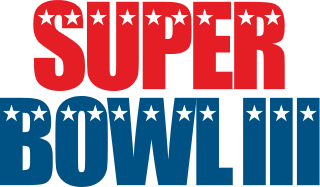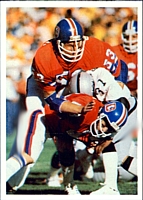
Super Bowl III was an American football game played on January 12, 1969, at the Orange Bowl in Miami, Florida. It was the third AFL–NFL Championship Game in professional American football, and the first to officially bear the trademark name "Super Bowl". Super Bowl III is regarded as one of the greatest upsets in both American football history and in the history of professional sports. The 19 1⁄2- points underdog American Football League (AFL) champion New York Jets defeated the National Football League (NFL) champion Baltimore Colts by a score of 16–7.
Super Bowl XI was an American football game between the American Football Conference (AFC) champion Oakland Raiders and the National Football Conference (NFC) champion Minnesota Vikings to decide the National Football League (NFL) champion for its 1976 season. The Raiders defeated the Vikings by the score of 32–14 to win their first Super Bowl. The game was played on January 9, 1977, at the Rose Bowl in Pasadena, California. This remains the earliest scheduled calendar date for a Super Bowl; and the most recent Super Bowl to begin before 4:00 p.m. ET.
Daryle Pasquale Lamonica was an American professional football quarterback who played in the American Football League (AFL) and the National Football League (NFL) for 12 seasons, primarily with the Oakland Raiders. Lamonica was drafted by the NFL Green Bay Packers in round 12 with the 168th overall pick. He spent his first four seasons mostly as a backup for the Buffalo Bills, who selected him in the 24th round of the 1963 AFL Draft. Lamonica played his next eight seasons as the primary starter of the Raiders, including after they joined the NFL through the AFL–NFL merger.

In American football, the Holy Roller was a controversial game-winning play by the Oakland Raiders against the San Diego Chargers on September 10, 1978, at San Diego Stadium in San Diego, California. It was officially ruled as a forward fumble by Raiders quarterback Ken Stabler that was recovered by his teammate, tight end Dave Casper, in the end zone for a touchdown, giving Oakland the 21–20 win. However, there have been differing interpretations of how this play should have actually been ruled, and it has remained a controversial play for fans of both teams involved. The NFL amended its rules after the 1978 season to prevent a recurrence of the play. Chargers fans refer to the play as the Immaculate Deception.

Kenneth Michael Stabler was an American professional football quarterback who played in the National Football League (NFL) for 17 seasons, primarily with the Oakland Raiders. Nicknamed "Snake", he played college football at Alabama and was selected by the Raiders in the second round of the 1968 NFL/AFL draft. During his 10 seasons in Oakland, Stabler received four Pro Bowl selections and was named Most Valuable Player in 1974. Stabler also helped the Raiders win their first Super Bowl title in Super Bowl XI. He was posthumously inducted to the Pro Football Hall of Fame in 2016.
David John Casper nicknamed "the Ghost", is an American former professional football tight end who played in the National Football League (NFL), primarily with the Oakland Raiders. Casper has been inducted into both the College Football Hall of Fame (2012) and the Pro Football Hall of Fame (2002).
The National Football League playoffs for the 2000 season began on December 30, 2000. The postseason tournament concluded with the Baltimore Ravens defeating the New York Giants in Super Bowl XXXV, 34–7, on January 28, 2001, at Raymond James Stadium in Tampa, Florida.

The National Football League playoffs for the 1970 season began on December 26, 1970. The postseason tournament concluded with the Baltimore Colts defeating the Dallas Cowboys in Super Bowl V, 16–13, on January 17, 1971, at the Orange Bowl in Miami, Florida.
The National Football League playoffs for the 1975 season began on December 27, 1975. The postseason tournament concluded with the Pittsburgh Steelers defeating the Dallas Cowboys in Super Bowl X, 21–17, on January 18, 1976, at the Orange Bowl in Miami.
The National Football League playoffs for the 1976 season began on December 18, 1976. The postseason tournament concluded with the Oakland Raiders defeating the Minnesota Vikings in Super Bowl XI, 32–14, on January 9, 1977, at the Rose Bowl in Pasadena, California.

The National Football League playoffs for the 1977 season began on December 24, 1977. The postseason tournament concluded with the Dallas Cowboys defeating the Denver Broncos in Super Bowl XII, 27–10, on January 15, 1978, at the Louisiana Superdome in New Orleans, Louisiana.
NFL Classics is a series of videotaped rebroadcasts of National Football League games that air on the NFL Network. The show airs weekly during the offseason and also occasionally during the NFL season. As of the 2010, the series airs on Monday night while Super Bowl Classics airs on Friday night.
The 1977 Baltimore Colts season was the 25th season for the team in the National Football League (NFL). Led by third-year head coach Ted Marchibroda, the Colts finished with 10 wins and 4 losses, tied for first in the AFC East division with the Miami Dolphins. The Colts had the tiebreaker over Miami based on better conference record, and the Dolphins missed the playoffs.
The 1979 Denver Broncos season was the team's 20th year in professional football and its 10th with the National Football League (NFL). Led by third-year head coach Red Miller, the Broncos were 10–6, second in the AFC West, and made the postseason a third consecutive year. In the Wild Card round the Broncos lost to the Houston Oilers 13–7.

The 1977 Oakland Raiders season was the team's 18th season overall, and 8th season since joining the NFL. The Raiders entered the season as the defending Super Bowl champions. The team could not improve on their 13-1 record from last year and finished 11-3, which was only good enough for second place in the AFC West next to the Denver Broncos, who won twelve games.
The 1978 Oakland Raiders season was the team's 19th season, and ninth as an NFL member.
Nelson Emory Munsey was an American football cornerback in the National Football League. He was signed by the Baltimore Colts as an undrafted free agent in 1972. He played college football at Wyoming.
The 1970 AFC Championship Game was the inaugural title game of the American Football Conference (AFC). Played on January 3, 1971, the game was hosted by the AFC East champion Baltimore Colts who played the AFC West champion Oakland Raiders at Memorial Stadium in Baltimore, Maryland. Along with the 1970 NFC Championship Game played on the same day, this game constituted the penultimate round of the 1970–71 NFL playoffs which had followed the 1970 regular season of the National Football League.
The 1975 AFC Championship Game was the sixth title game of the American Football Conference (AFC). Played on January 4, 1976, the game was hosted by the AFC Central champion and defending AFC and Super Bowl champion Pittsburgh Steelers who, in a rematch of the 1974 title game, played the AFC West champion Oakland Raiders at Three Rivers Stadium in Pittsburgh, Pennsylvania. Along with the 1975 NFC Championship Game played on the same day, this game constituted the penultimate round of the 1975-76 NFL playoffs which had followed the 1975 regular season of the National Football League (NFL).






